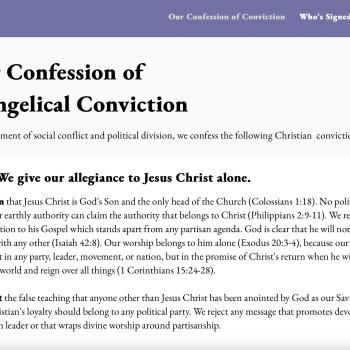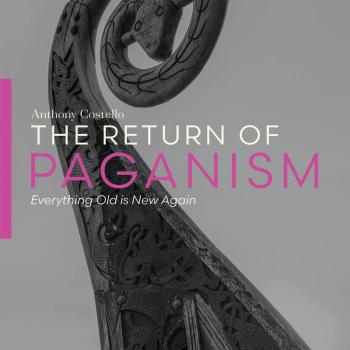In this series, I am reviewing 5 great Christian films (the 5 best that I have seen). In the first post, I discussed the greatest sports movie of all time, the original Rocky, and one of the greatest biopics of all time, Chariots of Fire. Both are aesthetically excellent films and deeply Christian with regard to their content. In this post, I have two films tied for 3rd place: Black Robe and The Mission. This is, in part, due to their thematic relatedness and the nature of their theological messages. Both films poignantly address the conflicted legacy of European colonialism and global missions. Each does so with both philosophical and historic nuance and genuine pathos.
Tied for #3: Black Robe (1991)
In a movie that took several years to find financing, due to its religious content and controversial theme, Black Robe (1991) is a realistic, raw and honest portrayal of Jesuit missionaries doing the work of evangelism in the hinterlands of 17th-century New France (Canada). Bruce Beresford’s film, based on Brian Moore’s novel, forcefully depicts an idea almost lost in today’s relativistic and anodyne western Church (be it Evangelical, Orthodox or Catholic). That idea is the necessity to preach the Gospel of Jesus Christ in order to save souls from eternal damnation. It is the type of idea that once drove men to sacrifice everything in its service: their wealth, their physical well-being, their familial aspirations and sexual desires, in short, the totality of their lives. As such, the movie offers us an image of something now quite foreign to the American Church: a Christian witness of absolute, single-minded conviction.
Total Abandonment for Christ
In the movie, we encounter Father Laforgue (Lothaire Bluteau), a Jesuit missionary sent to reach the native Huron with the Gospel. Laforgue is a man whose dedication to saving the souls of those he has been commissioned to evangelize is matched only by his profound concern for his own piety before God. Of course, the two are closely related. For it is only through the mortification of the flesh (his own desires) that Father Laforgue believes he can genuinely, and effectively, reach those in need of Christ.
This posture toward ministry may come off as excessive, especially to contemporary Evangelicals. However, the mortification of sin is not an exclusively Catholic notion. Reading any Puritan divine would remind us of this truth: that purity of heart and mind is part and parcel of suffering on behalf of those who are lost. We cannot divorce the imitatio Christi from our evangelism in nomine Christi. While the kind of self-flagellation that Father Laforgue performs (literally) may appear extreme to a culture that struggles with obesity, that asceticism has been part of the Christian commission since its inception is irrefutable (1 Cor 9).
Evangelicals today have, generally speaking, bought into a Gospel of “cheap grace,” where even sanctification (not salvation) is supposed to come easy. Further, in an era of church ministry where talent is valued more than virtue, and charisma more than the charisms (1 Cor 12:1-11), the travails of early missionaries, even Jesuits, can serve as a reminder of the close connection between our pursuit of holiness and our participation in the Great Commission.
With this theological corrective in mind, Evangelicals can be inspired by the history of even Roman Catholic missionaries. Like their Protestant counterparts, there were thousands of Catholic men and women who, in the colonial era, were willing to submit to the greatest hardships and most painful sufferings for the sake of the Gospel. Black Robe tells the story of just one of these saints. Thus, setting the problems of Catholic, and Jesuit, theology aside (of which there are many, especially the later), one can appreciate the great endeavor of prior generations to bring the Gospel into some of the harshest and most hostile environments.
In one scene, Father Laforgue flashes back to a time in France where he meets a grizzled veteran of the mission field to New France. The older priest is horribly mutilated. His face and hands show the battle scars of his campaign of love to those who do not know Christ. These losses of literal flesh foreshadow what will happen to Laforgue himself. Yet, the old priest longs to return to the mission field. He grasps its true nature: it is the greatest possible endeavor, the most glorious of all enterprises. It really is the bringing of light to those living in darkness. To paraphrase Kierkegaard, it is this single-mindedness toward one thing that exemplifies the purity of heart the missionaries possessed: a rarity in today’s world of “short-term” missions to relatively safe, technologically modern nations accustomed to receiving missionaries and tourists alike.
Christ in Cultural Context
Regarding the hostility of aboriginal groups to the Gospel and its messengers, Beresford shows unapologetically, and in exquisite detail, the ferocity with which many missionaries were welcomed by some natives. When the movie first released, there were complaints of racism by Native American groups, most notably the indigenist activist Ward Churchill. However, much of what Beresford represents in the film as to the torture missionaries endured was already sanitized for audiences. The historical atrocities committed against peaceful missionaries was far worse than what the movie depicts.
In being honest to the source material, Beresford is rejecting one of the great lies in modern history: the myth of the “noble savage.” The myth of the noble savage is itself a European fantasy, one usually attributed to Rousseau and his woefully mistaken view of man in the state of nature. Of course, even though the French in the film often refer to the native people as “savages,” it becomes clear rather quickly that the film is not playing favorites when it comes to vice, nor virtue. In spite of cultural differences, the Algonquin, Iroquois, Huron and French are all on equal moral grounds.
Thus, Beresford’s film, regardless of its critics, is not simplistic. It is not a story of Christian triumphalism or European superiority, at least as far as it concerns Christians and Europeans. Instead, the film handles the monumental theme of cultural collision with a transcendent eye. There is an aesthetic component that escapes Marxist categories of political and material power. Throughout the film, we are confronted with humanity, in its glory, its misery and its complexity. Black Robe gives us a sense of our shared human nature, a reality irrespective of who possesses the superior technology, political supremacy or even of who has knowledge of the true religion. Still, it is the bringing of true religion, the only hope for human nature, to those who have not heard that is the sole motivation of the film’s protagonist.
And so, while the film shows the native Iroquois could be as brutal as their European colonizers, the portrayal of indigenous people is subtle and nuanced. There is self-sacrifice and selfishness, cruelty and kindness, just as in any human society. Or, as alluded to by the older priest, there is barbarity like that of the German and British tribes of an earlier era who once lived without Christ. Biblically speaking, one has only to read the Old Testament to know that even the revealed law of God does not simply annihilate the lusts and drives of wicked men who possess it (Romans 7). And so there are ways in which the Indians, even apart from the Gospel, outstrip the French in virtue. However, when it comes to the issue of God’s grace and love, this is a stumbling block to the aborigines.
The Law Written in Their Hearts?
However, the movie treats indigenous spirituality with high regard. The film ultimately leaves open the question to what extent the one, true God of the Bible is present even in non-Christian religions, a tension Laforgue’s companion, the young Daniel (Aden Young), struggles to understand. This confusion is exacerbated by Daniel love (lust?) for the beautiful Annuka (Sandrine Holt), the daughter of the Algonquin chief assigned to transport Laforgue to the Huron mission.
In a pivotal scene, the chief, Chomina (August Schellenberg), who acts Father Laforgue’s protector and guide, dies on an isolated wilderness island. He rejects Father Laforgue’s explicit pleas to accept Christ to the very end. Although, it should be noted, that in Beresford’s film, Laforgue does not speak so much of Christ, as of God and entry into paradise. This is likely a theological inaccuracy of the film that most “fact checkers” will not bother to check.
After Laforgue and the rest of the party leave, a haunting, spectral image of the “She-Manitou” (or is it the Virgin Mary) is the last thing Chomina sees. It is an image that leaves the question of his personal salvation ambiguous. Did Chomina reject Christ, or only Father Laforgue? It is a difficult question to assess, especially as it is Chomina who sacrifices so much to save Laforgue, even calling him “friend” in is final words. Chomina’s sacrifice and noble death at least hint at a possible interpretation of Romans 2:12-16, perhaps not pluralistic with regard to salvation, but open to the possibility of God saving souls in ways that remain obscure to us. Even Laforgue, so confident at the outset of his mission, is forced to wrestle with the thought as he arrives at his journey’s end: the Huron village, now decimated by plague.
Finally, the movie captures the heart of the true missionary: the call to total abandonment for the sake of Christ. The closing scene is masterful, perhaps the best on-screen portrayal of Christian love ever filmed. The viewer not moved deeply in their soul by Black Robe’s final scene either has no soul to be moved, or may be in need of clinical observation. That said, non-believers who view Black Robe may not be able to fully appreciate its gravitas. The rationalist might view Laforgue’s mission as courageous, but ultimately delusion and foolish. The socialist, like Churchill, might see it as little more than thinly-veiled imperialism (although a very odd imperialism it would be). However, for the viewer whose soul is sensitive to the Spirit of God, Black Robe will not disappoint. It is truly one of the greatest Christian movies ever produced.
Tied for #3: The Mission (1986)
Thematically related to Black Robe, is Roland Joffé’s The Mission. The Mission matches Beresford’s film in aesthetic quality as well as its engagement with the most profound issues of human existence. Yet Joffé’s offering is somewhat less bleak and far more “Hollywood” than Beresford’s piece. The star studded cast consists of Jeremy Irons, Robert De Niro and Aidan Quinn (and a young Liam Neeson), to name but a few of the Hollywood icons involved in the project. Moreover, Ennio Morricone’s score may be the best soundtrack ever composed for film. Much could be said about Morricone’s music, which sets the auditory stage for the film’s most transcendent and intimate moments.
The Historical Background
Taking place roughly 100 years after the Jesuit missions in New France, and several thousand miles to the south, The Mission tells the story of Spanish Jesuits lead by Father Gabriel (Irons) evangelizing to the Guarani people of present day Paraguay. Historically speaking, small Jesuit villages, called “reductions,” started in the region of southern Brazil around 1609. These villages of converted natives grew rapidly. By the 1630’s a “Christian Indian State” emerged comprised of over 32 such Guarani Reductions. In his Church History, Fr. John Laux describes the layout and life of a Guarani reduction:
The site of a Reduction was chosen for its healthful climate and proximity to waterways. The plan of the village was square, with streets running in straight lines. In the center was the church, and nearby were the residence of the Fathers and the cemetery. The Indians, some of them, like the Caribs, just weaned from cannibalism, were taught to cultivate the soil, and, little by little, were instructed in all branches of industry. They cast bells and built organs. They made cannon[s]; they were good carpenters, masons, blacksmiths, carvers, and printers; the women manufactured calicoes of the finest qualities. Commerce was developed. Education was general, so that illiteracy was practically unknown. Many Indians could read Spanish and Latin as well as their own tongue. Part of the land was set aside as the ‘property of God,’ which the whole community had to till, in order to make provision for times of stress and scarcity and for the maintenance of the sick and the aged.
Laux, 472-473
However, as successful as the Jesuits were in bringing the Gospel to the Guarani, as well as useful, practical knowledge, the Christian reductions became heavily opposed by Spanish and Portuguese colonists. These “dons” sought cheap, slave labor to advance their own regional and material interests (Laux, 472-473). Laux continues:
In the 17th century the Reductions were the object of numerous attacks by the ‘Paulistas’ or Portuguese settlers of São Paulo, who disrupted many villages and carried the Indians off as slaves. The fatal blow was dealt to the Reductions in 1767, when Charles III of Spain signed the edict expelling the Jesuits from the Spanish colonies in America. Thus ended one of the most remarkable experiments in the history of Christian missionary enterprise.
Laux, 473
Even the arch-skeptic of the day, the rationalist Voltaire, had called the Jesuit Reductions “the triumph of humanity.” Although I imagine the Jesuits who planted the missionaries would have ascribed the victory to Christ, and not themselves or their native counterparts.
It is against this backdrop of intra-ecclesial controversy and conflict between culturally Catholic subjects, some of genuine Christian faith and others Christian in name alone, that The Mission’s historical fiction unfolds. While the movie starts off with a somewhat contrived fraternal feud between the Spanish slave-trader, Rodrigo Mendoza (De Niro), and his brother Felipe (Quinn), the set-up of fratricide merely serves a greater narrative thrust: Rodrigo’s conversion to Christ.
Of Politics and Repentance
While Joffe’s film wrestles on the one hand with the historical complexities of imperial politics and the Church’s role, for good or ill, in those politics, it nevertheless, like Black Robe, transcends the merely political. The Mission is ultimately a narrative of personal repentance and redemption, told primarily through the story of Rodrigo. After murdering his brother out of envy, Father Gabriel makes Rodrigo an offer that will enable him to avoid the full brunt of his crime, first legally, and then, as we find out, spiritually. Initially skeptical that anything can save him from his sin, or remediate his guilt, Rodrigo is ultimately convinced by Gabriel to accompany him to one of the Guarani reductions on the far side of the jungle. The ensuing journey comprises one of the most brilliant sequences in movie history.
Mendoza’s penitentiary pilgrimage is not just a physically exhausting trek, as he lugs his former implements of war across perilous wilderness escarpments. It is far more than that. It is a journey of spiritual ardor and passion, the beginning of the end of a former way of life, and the death of the man he used to be. The culmination of the scene is the most memorable of the entire film, a true cinematic tour de force. It is the type of scene that makes the viewer wonder how the same actor could play both the role of Rodrigo, as well as that of James Byrnes in Meet the Parents (2000). Yet, the portrayal of repentance and redemption is penetrating as Rodrigo’s redemption in Christ comes (literally) by the hand of those he once so brutally oppressed.
But, while spiritual redemption in the midst of man’s political machinations is the central theme of the film, The Mission also addresses other significant issues. The final scene of the movie deals masterfully with one of the most complex of human moral dilemmas, namely, the just use of violence.
Of Violence and Vindication
The Mission’s culminating scene is easily one of the best cinematic treatments of the notion of “just war.” In the wake of the 1750 “Treaty of Madrid” between Spain and Portugal, which ceded Spanish territories to Portugal where the slave trade was legal, the Guarani reductions became free game for Portuguese dons hell bent on profiting in the new world. As a joint Portuguese-Spanish army cohort approaches Father Gabriel and Rodrigo’s mission, Rodrigo (now a priest) pleads with Gabriel to defend the Guarani from the rapidly-approaching slavers. Yet Gabriel will not have it: the shedding of blood, even in the defense of the poor and weak, is not the way of Christ. It is not morally compatible with a God Who is love (1 John 4:8). Gabriel initially chastises his understudy, commanding him to help the Guarani “as a priest,” not as a soldier.
But in the heat of human passion and matters of life and death, renouncing the use of the sword often seems impossible. In their final interaction, Rodrigo, sword at his side, seeks Gabriel’s blessing. Gabriel will not bless Rodrigo’s military defense of the mission, but neither does he condemn Rodrigo. He simply says that he cannot live in a world where might really does make right. He, Gabriel, simply doesn’t have the strength for such a world.
As with Black Robe, the final scene leaves many questions unanswered. Both Rodrigo and Gabriel die at the hands of Portuguese gunfire, but in very different ways: Rodrigo in armed resistance, Gabriel walking headlong into a volley of canon fire while celebrating mass with fellow Guarani Christians. Who was right, who was wrong? It is hard to say, as any Christian soldier or military chaplain knows all too well, myself included. As to who is ultimately vindicated in the end, it seems only God can know.
Conclusion: Inconvenient Films in Times of Ecclesial Apology
Both Black Robe and The Mission are inconvenient films in today’s political and social climate. The main reason is obvious. For while both films present the history of Christian missionary activity in the new world with nuance and complexity, they nevertheless assume that the mission of the Church to bring the Gospel to aboriginal peoples was still worth it.
As such, in a country whose anti-Christian identity is now rivaled only by the most radical Islamic states, it is hard to think that a movie like Black Robe could even be made in Canada today. Further, as the current Pontiff of the Catholic Church continues to make grand apologies to indigenous nations on behalf of the Roman See, one’s suspicion of an ecclesiology inching ever closer to a formal embrace of soteriological pluralism seems increasingly warranted.
But Protestants need to take heed of these worrying trends in Roman Catholicism. We are not exempt from falling into the trap of condemning the totality of colonialism, to include the spreading of the Gospel that came with colonizers. In his 1984 book, The Subversion of Christianity, Jacques Ellul warns of this trend among Evangelicals to denounce the Church’s history en toto:
We have to avoid two errors. The first is that of rejecting all of the church’s past, of scorning and condemning all it has done, of saying categorically, as is unceasingly said today in an abominable fashion, that the church means obscurantism. On this view Judeo-Christian thinking is the cause or origin of every modern evil, of state absolutism, of capitalist alienation, of universal deception and hypocrisy, of Oedipus complexes or guilt, of the subordination of women, of the enslaving of the Third World, of the spoliation of nature….All evils [on this view] derive from the Judeo-Christian faith, and alongside these fierce and simplistic accusations we find a glorification of the pure and cheerful pagan, of a human and liberal polytheism, of a spiritual infancy that Christianity has supposedly rendered abortive.
Ellul, 7
The movies reviewed here are great films because they do not perpetuate this vicious mischaracterization of the Church’s missionary history. At the same time, they do not candy coat or whitewash the ugliness and partial complicity in colonial crimes, which would be the second error. In sum, they present history with a ring of truth. But within the din is the clarion call of the Gospel of Jesus Christ.














